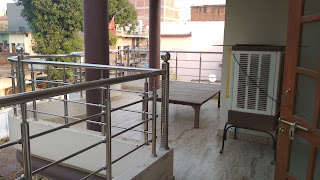The railing is the most beautiful item in construction. It not only provides beauty but also provides safety. Railing selection should be as per the building requirement and the area where it will be used. There are many types of railings like
1) Stainless steel railing
2) Wooden railing
3) Glass railing
4) Aluminum railing
5) Cast iron railing
6) FRP railing
7) GFRC railing
8) Plastic railing
9) Marble railing
These all are the type of railings used as per their area and requirement.
***
***
Stainless Steel railing
Stainless steel railings are mainly for commercial buildings and bungalows. S.S. railing is mainly of three types 304, 316, and 201. These numbers show the quality of stainless steel railing like 316 stainless steel has 17 % chromium, 12 % nickel, and 2 % molyb with other alloys. 304 stainless steel has 19 % chromium and 8 % nickel with other alloys. 201 stainless steel lacks these properties and is hence used only inner side where water is not used. chromium and nickel make stain steel water resistance and rustproof and molyb help in rust resistance from saltwater. Stainless steel railing does not require any type of coating, only polishing has been done for it to glow.
Wooden railing
Wooden railing is mainly used for bungalows, outhouses, and cottages. Teak wood is used for railing with wooden polishing. Wood is mainly preferred as in wooden lots of artwork is possible ( curving ) and also it gives traditional look. Wooden railing is mainly used inside the building, as it's very difficult to maintain outside ( direct exposure to sun and rain ). the wooden railing has also a major problem with termites.
Glass railing
The glass railing is very delicate and brittle. selection of such railing very important. These railings are mainly seen in bungalows in cutout and staircase areas. with only the bottom channel you can get frameless glass railings.
Cast Iron railing
Cast iron railing is seen mostly in antique buildings or retro houses or bungalows. Due to the presence of carbon up to 3 % of cast iron has a low melting point and we can easily get different kinds of cast iron railing designs. the railing is mainly used in balconies and stairs.
FRP railing
Fiber reinforcement plastic railing is mainly used for industrial purposes, like machine railing, process tank railing, and industrial staircase railing. As the FRP railing is not so strong as steel or wood it has a specific purpose to define the area.
GFRC railing
A glass fiber reinforcement concrete railing is utilized in many areas, that is residential and commercial. GFRC railing has many designs as it is made of molds. GFRC has better durability and life. For GFRC railing first design is selected and with that design, a mold is made. Now glass fiber is added to concrete with giving strength to the structure and that liquid form is poured into the mold. After a few hours products are ready to use. By adding color we can get the product as per the required color also.
Marble Railing
Marble railing is mainly seen in religious places. The piece of marble is cut and given the shape as required. Later polish work is done. India marble is best for this work as it is not hard and strong as Italian marble. This marble is fixed with its adhesives.
Mild Steel Railing
Mild steel railing is commonly used in industrial or residential areas. By simply fabricating the steel these railings are made. these railings look very simple with less design work.
R.c.c Railing
These railings are used for road works like bridges or flyovers. Even you will see these types of railings in the house terrace area. We can get a different kind of railing post as it is made from mold.
The stairs and staircases in a building can make or break the beauty of that building. A beautiful staircase and handrails is one of the main selling points. When it comes to handrails, there are four key materials that are used to make them: stainless steel, galvanized steel, concrete, and wood. These materials are commonly used to make handrails due to the cost and the quality.
Handrails are an often overlooked design feature in architecture and interior design; however, there are many options available for these areas. In this blog post, we examine the difference between stainless steel, wooden, iron, and concrete handrails. Handrails are usually the last thing that is given importance by the builders, but they are the most important part of any staircase. They are the first thing that a person sees when they enter the building. A poorly constructed handrail will look bad and will make the whole staircase look bad too. Not only do they need to be strong, but they should also be able to add a little bit of aesthetic value to the staircase. Handrails should not look like a boring pipes sticking out of the wall. They should complement the whole staircase. An attractive handrail can not only make your staircase look
1. Why you need a handrail: Whether you are planning to build a deck, or you are working on the remodeling one, the handrail would be one of the most important elements. It will ensure the safety and security of everyone who uses it. It is essential that the handrail is sturdy and durable enough. The rail will have to deal with the harsh weather outside, so you need to make sure it is made from high-quality materials.
2. Handrail Style and Materials: A handrail is more than just a handrail. It’s a piece of art, a piece of history, a piece of home. It’s a part of every staircase, and when your handrail is a little different, it’s a part of you. The stairs are usually the most used area of a house and a handrail should be a piece of art. A handrail can be made of different materials and have different styles. It can be plain, it can be intricate, it can be simple, or it can be complex. The main goal of a handrail is to be functional, but it can also be beautiful. All of our handrails have a beautiful design that has been individually created.
3. Ask the right questions when choosing handrail material: A handrail is a vital part of a staircase, ramp, or walkway. It provides a safe, secure, and reliable structure for people to hold on to when navigating stairs, steps, or a ramp. It's a design element that's certainly underappreciated, but when you choose the right material for your handrail, it can make all the difference in the world. Aesthetics, durability, and strength are just a few of the most important factors you need to consider when choosing a material. When building a new home or renovating a staircase, the design possibilities are endless. The final material choice can make or break the entire look of your home. Which material you choose for your handrail will depend on a number of factors. The look, the overall design, and the cost all play integral roles in your decision. Let’s talk about some of the most popular materials used for handrails.
4. The right handrail for any setting: Handrails are used for safety purposes and are a piece of safety equipment that should be in place at any public building. If you have a staircase in your home, you should consider installing a handrail. If you are looking to install a handrail, you will have a large number of different options at your disposal. The material you choose for your handrail will be the most important decision to make. You will have a number of different materials to choose from, including stainless steel, wooden, iron, and concrete. Each of these materials has its own unique traits. You will want to carefully consider the material you choose for your handrail before you make a final decision. Let’s take a look at all of these different handrail materials. Handrails are typically used to help people walk up or down the stairs. However, they serve a lot of other purposes. For instance, they can also be used as a decorative pieces in any setting. Handrails are available in a variety of materials. Some of these materials include concrete, wooden, iron, and stainless steel. The best handrail for any setting depends on the material the handrail is made of, the design of the handrail, the purpose of the handrail, the cost of the handrail, and the setting the handrail is placed in.
5. How to choose the right handrail for your property? As the world’s leading provider of handrails, we have a wealth of knowledge about the different materials used for handrails and the advantages that each material offers. Here we look at the pros and cons of each material used to make handrails. For each material, the pros and cons are related to the aesthetics, the cost, and the maintenance requirements.
Conclusion: Add style and safety to your home by adding a beautiful handrail.



